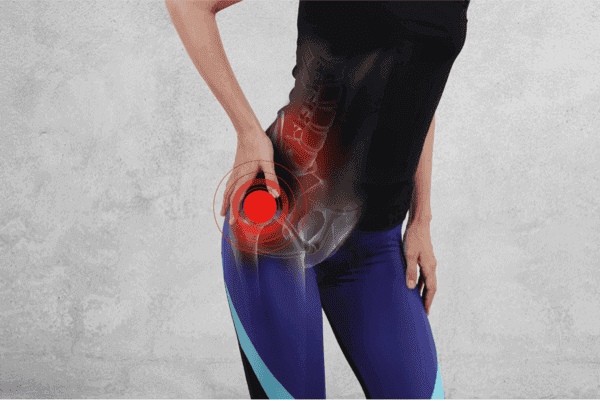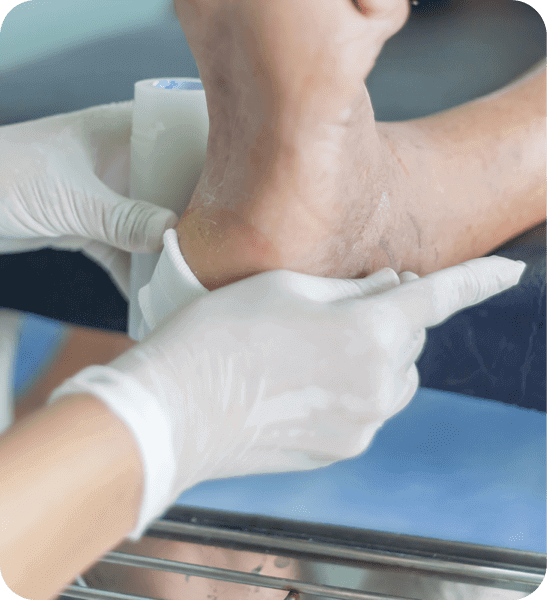Hyperbaric Oxygen Treatment for Crush Injuries
Crush injuries are complex and challenging to manage, often causing severe pain, extensive tissue damage, and high risk of complications. Hyperbaric oxygen therapy (HBOT) has proven to be an effective treatment, offering therapeutic benefits that can significantly improve patient outcomes. Recognized by Medicare and many private insurers, HBOT is increasingly used to treat crush injuries by promoting healing and reducing complications.

Crush injuries are complex and challenging to manage, often causing severe pain, extensive tissue damage, and high risk of complications. Hyperbaric oxygen therapy (HBOT) has proven to be an effective treatment, offering therapeutic benefits that can significantly improve patient outcomes. Recognized by Medicare and many private insurers, HBOT is increasingly used to treat crush injuries by promoting healing and reducing complications.
How Hyperbarics Helps
Possibility for limb preservation
Potential for enhanced functional outcomes
Augmented tissue oxygenation
Decreased edema
Facilitation of tissue healing and angiogenesis
Lowered risk of infection
What the Research Says
Hyperbaric oxygen therapy offers a comprehensive approach to the management of crush injuries, addressing key challenges such as tissue hypoxia, edema, and infection risk. By enhancing tissue oxygenation, promoting healing, and reducing complications, HBOT can significantly improve the prognosis for patients with crush injuries, making it a valuable tool in the modern medical arsenal. As the evidence for its efficacy continues to grow, HBOT is an integral part of the treatment protocol for these complex injuries. Both Medicare and many private insurance companies pay for the cost of hyperbaric oxygen therapy to heal crush injuries.
Here are some of the ways in which HBOT can help treat crush injuries:
1. Potential for Limb Salvage: Crush injuries often result in extensive damage to muscles, nerves, and blood vessels, which can threaten the viability of the affected limb. HBOT can play a crucial role in limb preservation by improving tissue oxygenation, thereby enhancing the body’s natural healing processes. This increased oxygenation aids in reducing the extent of tissue necrosis, promoting cell survival, and ultimately increasing the likelihood of limb salvage.
2. Potential for Enhanced Functional Outcomes: Functional recovery is a key goal in the treatment of crush injuries. HBOT helps by facilitating the repair of damaged tissues and reducing the overall recovery time. By improving oxygen delivery to the injured areas, HBOT supports the regeneration of tissues, which can lead to better functional outcomes and a faster return to normal activities for the patient.
3. Augmented Tissue Oxygenation: One of the primary mechanisms by which HBOT benefits crush injury patients is through the substantial increase in tissue oxygenation. Crush injuries can severely compromise local blood flow, leading to hypoxia in the affected tissues. HBOT can increase the oxygen concentration in the blood by up to 1,200%, ensuring that even the most deprived tissues receive the oxygen necessary for repair and regeneration. This enhanced oxygenation also promotes the growth of new blood vessels, further improving blood supply to the injured area.
4. Decreased Edema: Swelling is a common and problematic symptom of crush injuries, contributing to pain and further tissue damage. HBOT has been shown to reduce edema by constricting blood vessels and reducing the permeability of capillaries, which in turn decreases fluid leakage into tissues. This reduction in swelling not only alleviates pain but also helps prevent additional complications that can arise from prolonged edema.
5. Facilitation of Tissue Healing and Angiogenesis: HBOT promotes healing by stimulating the production of collagen, a key component of tissue repair, and by enhancing angiogenesis, the formation of new blood vessels. These processes are crucial for the repair of damaged tissues in crush injuries, where the restoration of normal blood flow and tissue integrity is essential for recovery. The promotion of new blood vessel growth also helps in the long-term restoration of the affected area’s function.
6. Lowered Risk of Infection: The risk of infection is a significant concern in crush injuries, especially in cases where open wounds are present. HBOT creates an oxygen-rich environment that is hostile to anaerobic bacteria, which cannot thrive in the presence of high levels of oxygen. Additionally, the therapy boosts the effectiveness of the immune system, enhancing the ability of white blood cells to fight off infection. This dual action reduces the risk of infection and supports the overall healing process.
At Bay Area Hyperbarics, we work with referring physicians to help heal patients with crush injuries. In doing so, patients report higher satisfaction with their referring physician and care team, and are healed at much higher percentage than without hyperbaric oxygen therapy. We follow all standard protocols and our physicians and nurse practitioners work closely with your care team.
Please give us a call today to discuss your patients or have your care team download our patient referral form. We can get patients in quickly and get them on the road to recovery.
Research Studies
Our Experiences with Hyperbaric Oxygen Therapy in Paediatric Orthopaedics.
Our Experiences with Hyperbaric Oxygen Therapy in Paediatric Orthopaedics.
Is hyperbaric oxygen therapy indispensable for saving mutilated hand injuries?
Is hyperbaric oxygen therapy indispensable for saving mutilated hand injuries?
Hyperbaric Oxygen Therapy in Upper Limb Crush Injury: Why and When?
Hyperbaric Oxygen Therapy in Upper Limb Crush Injury: Why and When?
Patient Experiences
-

Lisa, 44
After seven years of suffering, hyperbaric oxygen therapy healed her osteomyelitis.
Lisa St John, the clinic director for Bay Area Hyperbarics, had chronic refractory osteomyelitis that lasted seven years with no relief. The infection induced severe fatigue and cognitive impairment that prevented her from working, and required her to sleep up to 18 hours per day. Finally, a physician recommended hyperbaric oxygen therapy with antibiotics, which after 60 treatments, healed her. Shortly after being healed, she sold her home to begin her first hyperbaric oxygen therapy clinic, which she has owned for almost 25 years!
-

Jennifer, 68
Hyperbaric oxygen therapy eliminated the need for surgery to heal her bone infection.
Jennifer had osteomyelitis of the lower jaw (mandible), which proved difficult to heal. Her teeth were becoming loose, and her doctor thought she would need surgery. However, he prescribed hyperbaric oxygen therapy before the surgery, and after 60 treatments, her chronic refractory osteomyelitis healed completely, regrowing bone in her mandible. Jennifer was able to keep her teeth, and was able to return to her active lifestyle, hiking regularly with her husband.
Physicians: Refer a Patient
You Submit Your Patient’s Information
We Get Authorizations
Patient Starts HBOT

Related Articles
Research on Hyperbaric Oxygen Therapy
-
What is Hyperbaric Oxygen Therapy?
Hyperbaric oxygen therapy treats medical conditions with 100% oxygen in a pressurized hyperbaric chamber. The patient lies or sits in the chamber. The oxygen then saturates the plasma in the blood, allowing oxygen to easily flow throughout the body and reach even areas that are injured or diseased, which typically receive less oxygen. The mechanisms of hyperbaric oxygen therapy include stimulating and mobilizing stem cells, down-regulating inflammatory genes, up-regulating reproductive cells and stimulating DNA. HBOT also regrows tiny blood vessels, and stimulates the growth of new healthy cells in the brain, bones, skin, organs, and tissues. People seek hyperbaric oxygen therapy to heal physical damage in their bodies and to promoting health and anti-aging.
-
Does HBOT kill cancer cells?
Current research indicates that hyperbaric oxygen does not kill cancer cells. However, there has been a small amount of research indicating that hyperbaric oxygen might reduce the size of certain tumors. Also, there has been a study on mice using hyperbaric oxygen, along with a ketogenic diet, to reduce tumors. Hyperbaric oxygen causes many different healing modalities to kick into gear. Could its effect on strengthening the immune system inhibit the growth of cancer cells? Nobody knows. There are numerous studies conclusively showing that hyperbaric oxygen does not encourage cancer cells or tumors to grow. Some patients claim the hyperbaric oxygen makes them feel a lot more comfortable and functional after chemotherapy and also during healing. Note that some chemotherapy drugs are not to be used with hyperbaric oxygen, as the chemotherapy drugs can be enhanced and thus become toxic. A good hyperbaric oxygen facility (such as Bay Area Hyperbarics) will always call the chemotherapy manufacturer to ensure that hyperbaric oxygen therapy will be helpful and not damaging to the patient.
-
IWhat is the CPT code for HBOT?
The CPT code for HBOT is G0277.
-
Does Medicare cover HBOT?
Medicare covers Hyperbaric Oxygen Therapy for approved conditions, and many insurance companies also cover approved conditions. If your condition is not approved by your insurance, we can discuss our special rates. Give us a call at (408) 356–7438. We are happy to discuss your options with you.
-
Can HBOT help Neuropathy?
Hyperbaric treatments help heal neuropathy by regrowing small blood vessels and nerves that have died from disease, injuries from radiation and aging. Patients often experience numbness and or pain when they start treatment. Hyperbaric treatments most often bring back sensation and make, for example, walking easier and more enjoyable.
-
Why would a physician consider HBOT?
A physician would consider using hyperbaric chamber therapy under a variety of situations. Physicians most typically refer patients to hyperbarics when the patient is not healing with traditional medical interventions and hyperbaric chamber therapy is approved by Medicare for this condition. Some patients experience significant unresolved pain and unremitting disease states that the mechanisms of hyperbaric oxygen therapy in a hyperbaric chamber are known to affect, such as the down regulation of inflamatory genes. For an example, some patients have experienced severe, unremitting hives with itching, which did not improve with any specialists interventions. Some physicians will consider hyperbaric chamber therapy if the patient has no other good avenues for improving their failing health, and they know the hyperbaric chamber therapy is safe and will not harm the patient.
-
What is Hypebaric Oxygen Therapy?
Hyperbaric Oxygen Therapy (HBOT) Hyperbaric Oxygen Therapy (HB0T) is a medical treatment where you inhale 100% oxygen in a chamber with increased atmospheric pressure. HBOT injects 400x the oxygen into your tissues and bones and mobilizes stem cells. It regrows healthy tissues in the brain, blood vessels, skin and bones. It also reduces pain and swelling, and speeds recovery. It is simple, effective and painless.
Have more Questions?




